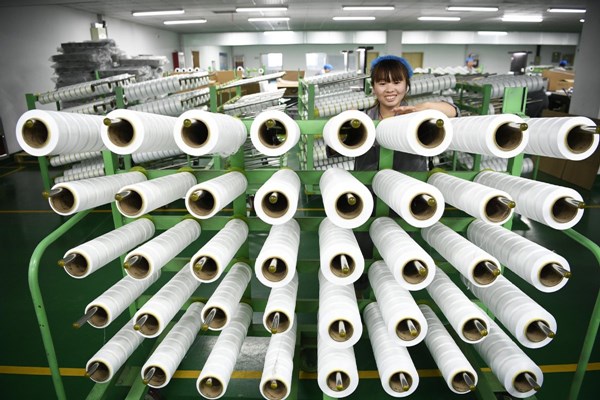China Energy chief says green measures are key

A technician works on the Nomex production line of a subsidiary of China Energy in Lingwu, the Ningxia Hui autonomous region. [Photo/Xinhua]
Ling Wen, president & CEO of China Energy, said the State-owned company will continue its efforts in the clean and efficient use of coal, and will further promote clean energy including hydrogen energy, to meet China's commitment to combat climate change.
The company, which was established in 2017 following the merger of Fortune 500 companies China Guodian and Shenhua Group, is now the world's largest producer of coal, thermal power, wind power, coal-to-liquids and coal-to-chemicals.
It has solved safety issues in coal production, and made remarkable progress in upgrading efficiency, apart from supplying quality coal to meet increased energy demand resulting from China's robust economic growth, said Ling, a member of the 13th National Committee of the Chinese People's Political Consultative Conference (CPPCC).
"After solving safety and efficiency issues, the main challenge in the coal sector is environmental protection," Ling told China Daily during the ongoing two sessions.
He also said the world needs cooperation throughout not only in companies, but also in universities, governments and financial institutions, to address environmental problems such as climate change.
Ling predicted that, in China's total primary energy consumption, coal will drop by about one percentage point each year, because as the Chinese economy grows and energy demand increases, the energy mix will optimize to have more renewables.
He said China Energy will further improve the clean and efficient use of coal, while facilitating clean renewables such as wind and hydrogen energies.
Producing 16 percent of the total coal output in China, China Energy attaches great importance to environmental protection, by adopting effective measures and advanced technologies.
Its mining process is 100 percent mechanized, with an intelligent control system, and it has developed techniques to turn the explored underground coal pits into water reservoirs in order to protect groundwater resources.
For instance, the 35 water reservoirs in the Shendong coal mine areas in northwestern China hold 27 million cubic meters of water in total, equal to twice the volume of the West Lake in Hangzhou, Zhejiang province.
Besides, China Energy also plants trees to protect the ground surface of coal mines, and the average vegetation ratio at its coal mines has increased to more than 70 percent from just 3 to 10 percent before mining.
In 2014, the company's Zhoushan Power Plant became the world's first ultra-low emission coal-fired power unit. Now 98 percent of its 163 coal fired power plants have achieved an ultra-low emission standard.
As a result, the emission of dusts, sulfur dioxide (SO2) and nitrogen oxides (NOx) - the main pollutants from burning coal - are respectively two, two and 19 milligrams per cubic meter, even much lower than China's emission standards for gas turbines, which are five, 35 and 50 milligrams per cubic meter.
Specifically, China Energy has the largest coal-to-hydrogen production capacity in China and in the world.
Ling, who is also an academician of Chinese Academy of Engineering, said as a scientist, he regards hydrogen energy as an "absolute clean" energy because it only has water as a byproduct while being produced and consumed.
According to the Hydrogen Council, deployed at scale, hydrogen could account for almost one-fifth of total final energy consumption by 2050, which would largely reduce emissions and contribute to containing global warming.
Ling believes China has very great potential in developing hydrogen energy. China is rich in hydrogen resources with an annual production capacity of more than 25 million metric tons. And China has huge hydrogen market demand due to the booming growth of new energy vehicles.
China Energy has been working on promoting hydrogen production and utilization in China.
It initiated and sponsored the China National Alliance of Hydrogen and Fuel Cell to promote low-cost hydrogen production, transportation, and the establishment of industry standards such as those regarding hydrogen refueling stations.
"We are now in the leading position in China's hydrogen energy sector, and we hope we can bring together all parties in the hydrogen community, calling for 'a hydrogen society' in China," Ling said.
Copyright © 2025 The National Committee of the Chinese People's Political Consultative Conference.
All rights reserved. Presented by China Daily.
京ICP备08100501号-1

